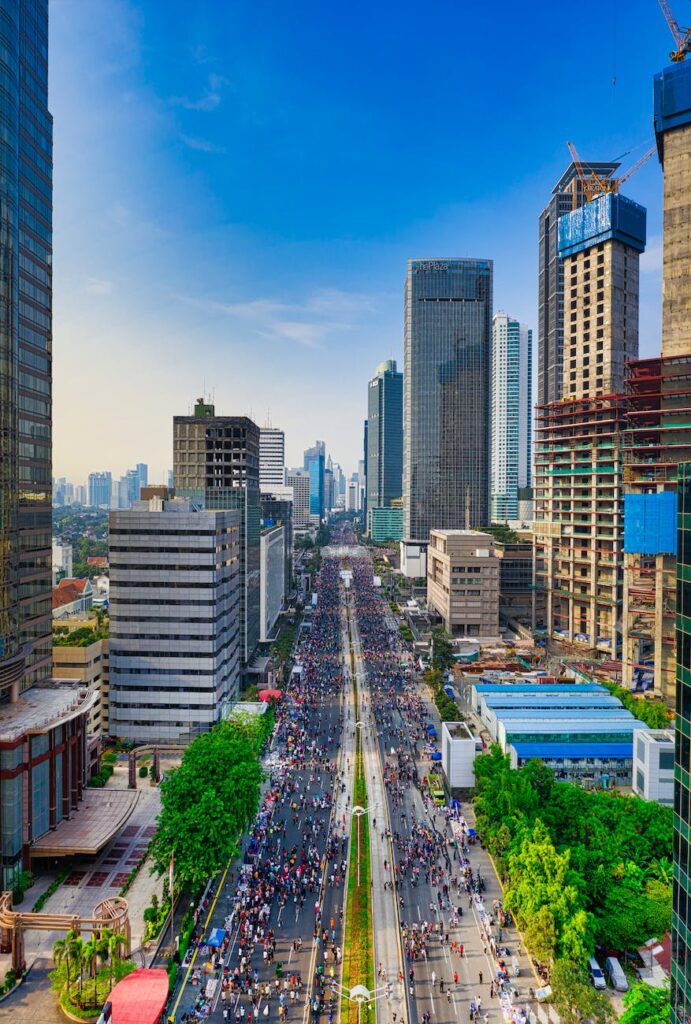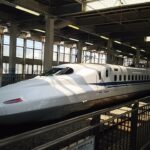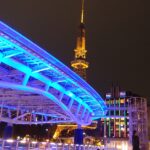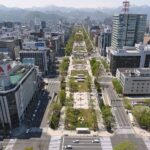Indonesia’s capital, Jakarta, has a sizable and effective public transportation network. There is a comprehensive network of taxis, ferries, commuter trains, and buses in Jakarta. The most widely used modes of public transportation are buses and commuter trains, which offer the most cost-effective ways of travel. A recently built metro system that provides quick and effective transportation around the city is the Jakarta MRT. The several islands that make up the Jakarta Bay area are served by ferries on a regular basis. Last but not least, for individuals who prefer a more secluded and pleasant ride, taxis offer a practical mode of transportation.
Metro system in Jakarta – Basic information
The Jakarta metro system makes getting around the city easy and reasonably priced. It only only one line. PT MRT Jakarta, a division of the state-owned company PT Kereta Api Indonesia, runs the metro system. A minimum cost of Rp3,500 and a maximum fare of Rp14,500 are charged depending on the distance traveled. With its convenient and dependable means of getting throughout the city, Jakarta’s metro system is a crucial component of the city’s public transit system.
The lines of the Jakarta subway system
The North-South line is the first rapid transit line of the Jakarta MRT system, connecting the Lebak Bulus area in South Jakarta with Ancol in North Jakarta. The line is currently 15.7 km long and serves 13 stations, with seven elevated stations and six underground stations. The elevated section spans approximately 10 km, while the underground section spans approximately 6 km. The line is planned to intersect with the East-West line at Thamrin Station.
Funding for the North-South line was provided by soft loans from the Japan Bank for International Cooperation (now merged to Japan International Cooperation Agency), with a tenor of 30 years and a grace period of 10 years.
Each station on the North-South line is equipped with various facilities, such as free WiFi, disabled-friendly toilets, ATMs, retail kiosks, nursing rooms, and prayer rooms. Flood barriers are also installed at every station to ensure they remain flood-free. The plan is for each station to be connected to a transit-oriented development (TOD) area, with Dukuh Atas Station already connected to the KRL Commuter line and Soekarno-Hatta Airport Rail Link through the Dukuh Atas TOD. TODs can take the form of public facilities and housing around the station, as well as improving access to other modes of transportation.
Overall, the North-South line represents an important step forward in Jakarta’s public transportation system, providing faster and more convenient travel options for commuters in the city.
Map of Jakarta Metro 2023 – Free Download in PDF
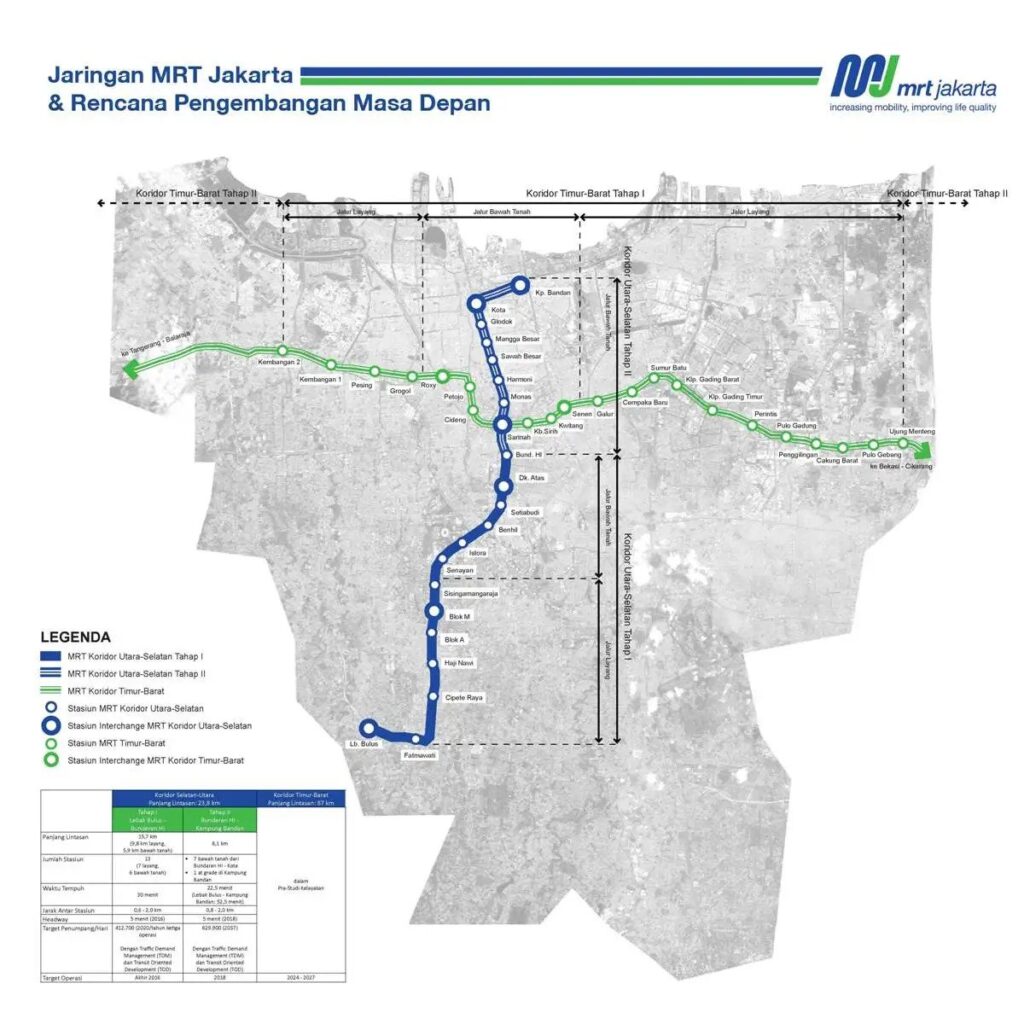
Click on the image and download the map of Jakarta´s underground system for 2023
A vital resource for navigating Jakarta’s crowded city is the Jakarta Metro 2023 map. You can get an overview of the wide public transit network in the city using this free, printable PDF map. Along with bus routes and other forms of transportation, it features all the major railroad lines. This map makes it simple to plan your itinerary in advance and identify the best paths to get you where you need to go. It is a priceless tool for anyone visiting or residing in Jakarta. The Jakarta Metro 2023 map is a useful resource for both visitors and locals.
Public transport tickets in Jakarta – Best types for travelers & actual prices
The city’s public transportation system makes it incredibly easy to move around Jakarta. Jakarta offers a range of ticket options to meet your needs, whether you’re a frequent commuter or a guest. There are a few different ticket types available, depending on whether you will be in Jakarta for a brief visit or a longer stay.
E-tickets and plastic tickets are the most widely used modes of transit in Jakarta. The e-tickets are available in the form of a smartphone app, and can be purchased for one-way trips or for several excursions. These tickets are usually cheaper than plastic tickets and are usable for a specified amount of time. The conventional ticket type is plastic, and it may be obtained from ticket booths scattered across the city. Similar to e-tickets, these tickets can be used on several occasions and are slightly less expensive.
For individuals who are in Jakarta for a short period of time, the ideal option is to acquire a one-day pass. These provide limitless rides for a single day and are offered in both e-ticket and physical ticket types. Depending on the mode of transportation you choose, the price of the one-day pass varies, with the most expensive one costing roughly $10.
There are also multi-day passes available for those who intend to stay in Jakarta for a few days. These are available for purchase in plastic and e-ticket forms, and they provide unlimited rides for three or seven days. The three-day pass is approximately $25, while the seven-day pass is approximately $45.
The best choice for visitors staying in Jakarta for three days is to buy a three-day pass. With unlimited rides included for the duration of your stay, you can fully enjoy your time in Jakarta. The three-day pass is very reasonably priced and gives you the freedom to explore the city without having to worry about transportation expenses.
Summary of fares for public transport in Jakarta
- A one-day pass offers unlimited rides for one day and is available in both e-ticket and physical ticket types, with the most expensive one costing about $10.
- E-tickets can be purchased for one-way trips or several excursions, and are typically less expensive than plastic tickets.
- For visitors who plan to stay in Jakarta for a few days, there are multi-day passes available.
- The three-day pass costs roughly $25, while the seven-day pass costs approximately $45
Timetables & Schedules of Jakarta Metro system
Rapid transit is available throughout Jakarta, Indonesia, thanks to the Jakarta Metro system. The company that runs it is PT Transportasi Jakarta (PTJ). There are two lines and 13 stations in the Jakarta Metro system. The two lines are the Red Line, which travels from Kampung Bandan to Kampung Melayu, and the Blue Line, which connects Lebak Bulus and Bundaran HI. Trains run at approximately 15-minute intervals during peak hours and 20-minute intervals during off-peak hours on a daily basis from 5:00 a.m. to 11:00 p.m. In order to avoid standing in long lines during peak hours, passengers are urged to buy their tickets in advance.
What Are Other Options For Public Transportation In Jakarta?
Over 10 million people live in the thriving metropolis of Jakarta, the capital of Indonesia. Many people are searching for alternatives to the metro because of the city’s rapid growth. Fortunately, Jakarta offers a wide range of public transit options.
In Jakarta, buses are among the most widely used modes of transportation. Transjakarta, the city’s bus network, has over 400 routes and is the biggest in Southeast Asia. In addition, it is the most cost-effective method of transportation, with fares starting at just 3,000 IDR (about 20 cents). The routes, however, can be challenging to follow and the buses can become congested.
The Angkot is a shared minibus alternative that is another well-liked choice. These compact buses travel around Jakarta and are frequently flagged down by drivers at the side of the road. Generally speaking, they are less expensive than Transjakarta buses, but prices can vary from driver to driver.
In Jakarta, motorcycles are a common kind of transportation. Ojeks, or motorcycles, can be a practical and reasonably priced mode of urban transportation. The cost of renting a motorcycle or hiring a driver depends on how far the trip is.
Another choice is a taxi, albeit they are typically more expensive than other modes of transportation. Fares begin at around 8,000 IDR (around 50 cents), and the bright yellow cabs are simple to detect. However, there is frequently an additional fee for evening and nighttime rides, so it’s crucial to double-check the ticket before boarding.
Finally, a recent development in the city’s public transportation network is the MRT. There are trains that go from the east to the west of the city in this rapid transit system. The MRT is often quicker and more pleasant than other Jakarta public transit options, with fares starting at about 8,000 IDR.
In general, Jakarta offers a wide range of public transportation alternatives. There is a way for you to move around the city, whether you’re seeking for comfort, cost, or speed.
How To Get From Soekarno-Hatta International Airport (cgk) To The City Center With Public Transport?
The main entry point into Indonesia’s thriving capital city of Jakarta is Soekarno-Hatta International Airport. You might need to know how to get from the airport to the city center whether you are visiting for business or pleasure. Fortunately, you can get from the airport to your destination in the city center using a variety of public transportation options.
The Airport Rail Link is the most well-known method of transportation between Soekarno-Hatta International Airport and the city’s core. From the airport to Manggarai Station in the heart of the city, the Airport Rail Link offers nonstop express service. Tickets are available at the airport, and the trip takes about 40 minutes.
There is a dedicated airport shuttle service that leaves from outside the airport terminal and travels to the city center if you would rather ride a bus. Damri runs the shuttle service, and it takes around an hour and a half to get there. You can buy tickets at the airport.
Numerous private taxi companies run out of Soekarno-Hatta International Airport for those seeking a little more comfort. These include the fixed-price transportation options Bluebird, Express, and Silver Bird to and from the airport. Tickets are available at the airport and the trip takes around an hour.
Finally, if you prefer to travel by car, there are a variety of regional as well as Hertz, Avis, and Europcar car rental agencies available at the airport. These provide rental cars for a predetermined cost, and for an additional cost, you can arrange to have the vehicle delivered to the airport.
Regardless of the route you take, it is simple and convenient to go from Jakarta’s Soekarno-Hatta International Airport to the city center. You can quickly get from the airport to your destination in the heart of the city by using the Airport Rail Link, a shuttle, a private cab, or a rented automobile.
What kind of sightseeing do you have to see if you visit Jakarta for the first time?
The capital and largest city of Indonesia, Jakarta, is home to some of the most breathtaking landmarks on earth. The city attracts visitors from all over the world who want to enjoy its thriving culture, gorgeous architecture, and mouthwatering cuisine. The best Jakarta tourist destinations are listed here for visitors who want to experience the city.
Old Town, commonly known as Kota Tua, is a must-visit location. There are several colonial-era structures, museums, and cafes in this part of the city. By visiting the Fatahillah Museum, strolling around the cobblestone alleyways, and taking in the elaborate architecture, visitors can learn more about Jakarta’s history.
One of the most recognizable structures in Jakarta is the National Monument (Monas). The 132-meter-tall obelisk in the center of Merdeka Square is a fantastic location to obtain a bird’s eye view of the city. For breathtaking views over Jakarta and to observe the monument’s gold-plated flame, visitors can take the elevator to the top of the structure.
A visit to Ancol Dreamland is a must on every vacation to Jakarta. There are many attractions located within this vast entertainment complex, including a beach, an amusement park, and a water park. This well-known location offers visitors exhilarating rides, delectable cuisine, and unlimited entertainment.
Last but not least, be sure to visit Taman Mini Indonesia Indah. The greatest of Indonesian culture and tradition are on display in this cultural park. Visitors can tour the different islands and lakes as well as a variety of traditional homes, temples, and monuments.
The city of Jakarta is home to many amazing attractions. There are attractions from Kota Tua to Taman Mini Indonesia Indah to satisfy every taste. With so much to discover, it’s understandable why travelers swarm to this dynamic city.
Summary of our tour guide for Jakarta
Located on the Java island’s northwest coast, Jakarta is the vibrant capital of Indonesia. With more than 10 million residents, it is a large metropolis that is renowned for its thriving culture, various neighborhoods, and rapid economic development. Jakarta has an efficient public transportation system that includes a vast network of buses, minivans, trains, and ferries. The city also has three commuter train lines and is currently building a new light rail system. When feasible, use public transportation because traffic might be chaotic.
Top 5 FAQs and answers about Jakarta public transport?
What kinds of public transportation are offered in Jakarta?
- In Jakarta, there are several different ways to get around the city, including buses, trains, taxis, and ojek (motorcycle taxis). The most popular kind of public transportation, buses serve a large portion of the city. Trains are a quick and effective way to travel within the greater Jakarta area. Though they can be pricey, taxis can be found all over the city. In Jakarta, ojek are a well-liked mode of transportation, particularly for shorter distances.
In Jakarta, how much does public transportation cost?
- Depending on the mode of transportation and the distance traveled, public transportation in Jakarta has varying costs. Bus prices typically start at roughly 2,500 IDR, making them the least expensive. Train travel is slightly more expensive, with short trips starting at roughly 10,000 IDR. Depending on the distance, taxi rates might range from 15,000 to 25,000 IDR. Ojek fares often start at roughly 25,000 IDR, making them the most expensive.
What are the public transportation schedules in Jakarta?
- In Jakarta, public transportation typically runs from 5am to 10pm. However, depending on the mode of transportation, the operating hours may change. Trains run from 6am to 10pm, while buses typically run from 5am to 8pm. Ojek and taxis are available around-the-clock, but prices will be higher in the early morning and late at night.
Is Jakarta’s public transportation safe?
- While it’s always vital to exercise caution, Jakarta’s public transportation is generally safe. Avoid traveling alone at night if possible, and always keep your belongings near to you. Check the driver’s license before boarding the motorcycle if you’re utilizing an ojek.
In Jakarta, how do I pay for public transportation?
- Cash is accepted on the majority of Jakarta’s public transportation systems. However, there are also alternatives for using debit or credit cards to make payments. While ojek often only accept cash payments, buses, trains, and taxis all accept cards. Additionally, there are mobile apps that let you use your phone to pay for public transportation.
Useful links

